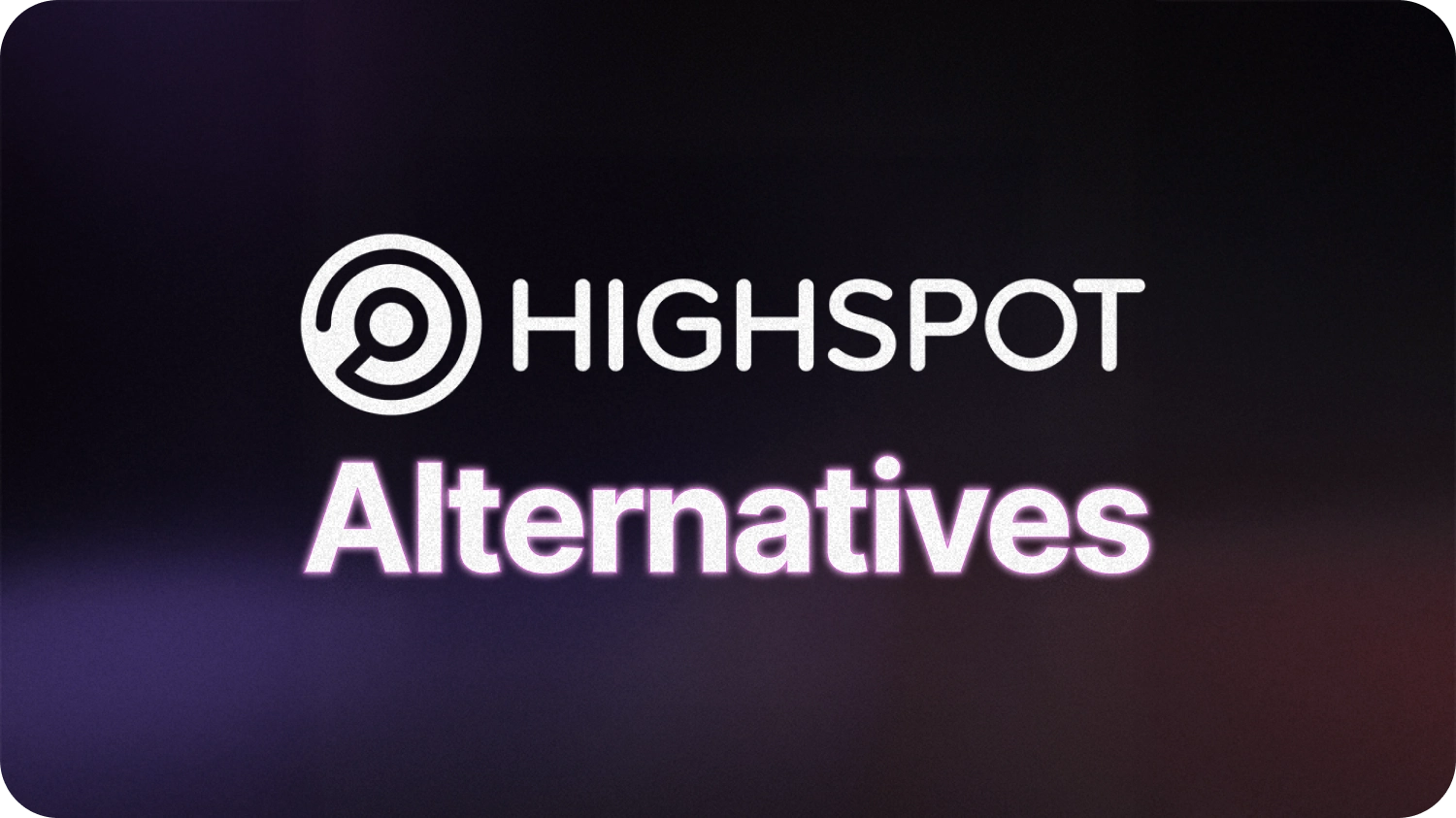Struggling to get real sales results from your enablement tools? You’re not alone. In this guide, we’ll compare the top Seismic competitors of 2025 , from AI-driven coaching platforms to streamlined content hubs, so you can find the best fit for your team.
It’s a new quarter. Your sales team is fired up, but they’re a bit all over the place. One rep is digging up a slide deck from last year, another is using some new messaging, and a fresh hire is winging it on demos. The enthusiasm is there, but the consistency? Not so much. That’s when deals start to slip away, and when sales leaders start looking beyond Seismic for a platform that can bring structure, agility, and smarter insights to their enablement process.
Seismic has long been a popular sales enablement platform designed to solve exactly this issue: it gives revenue teams one hub for content management, training, and analytics across the sales cycle. For many organizations, Seismic became the backbone of enablement – the central place to store playbooks, decks, and data on what content sellers use.
However, the sales enablement landscape has evolved. In fact, 83% of sales teams using AI reported revenue growth in the past year, versus only 66% of teams without AI. AI isn’t replacing human sellers; it’s enhancing their performance, quietly becoming the driving force behind stronger pipelines and sharper execution. This shift has also uncovered a gap: having a great content library is one thing, but ensuring reps can effectively use it (with the help of real-time coaching and AI guidance) is another.
In this article, we’ll explore the top Seismic competitors and alternatives for 2025, breaking down how each platform helps you enable faster, coach smarter, and connect training directly to revenue growth.
What is Seismic?
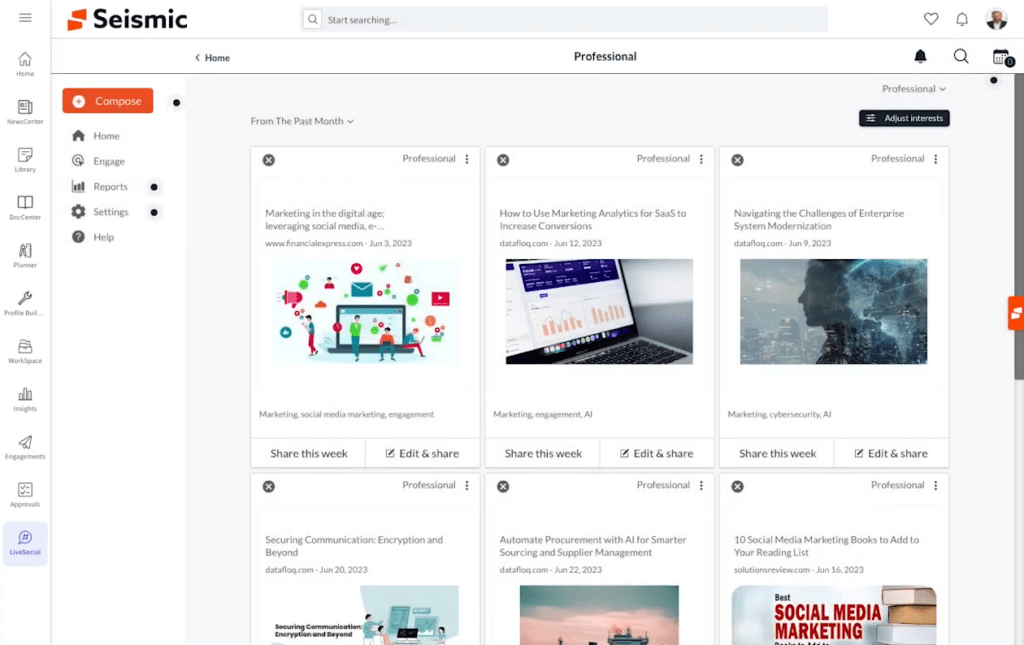
Seismic is a sales enablement platform that operationalizes how effective selling happens. It’s an enterprise-grade solution that connects strategy to execution by aligning content, messaging, and training with deal performance and buyer engagement data. More than just a content repository, Seismic functions as a system to help sales teams replicate what works and drive consistent outcomes.
Key features include a central content library (with version control and dynamic content assembly), training modules (bolstered by Seismic’s acquisition of Lessonly for LMS capabilities), and analytics that track content usage and engagement. Seamless CRM and email integrations allow sellers to find and personalize content within their workflow.
While Seismic remains one of the most established platforms in the category, newer competirtors are expanding the very definition of enablement – integrating conversation intelligence, AI-driven coaching, real-time deal insights, and even AI role-play simulations to bridge the gap between learning and live performance. These emerging tools focus not just on managing content, but on improving how reps actually sell in real time.
Why Companies Explore Alternatives to Seismic
Seismic delivers well on content management and training for large teams. But when today’s sales leaders aim to boost rep performance fast and tie enablement directly to revenue, many find Seismic falls short in a few areas. Even with tons of content loaded and courses completed, sales performance can stall, because simply having content doesn’t guarantee reps use it effectively when it counts. Modern teams need more agility, personalized coaching, and proof of ROI from their enablement investments. Here are the main reasons teams are re-evaluating Seismic in 2025:
- Heavy and Hard to Adopt: Seismic is powerful, but also complex to implement and navigate. It often takes months (and dedicated staff) to roll out and organize content. As one analysis noted, “Seismic is complex to implement, hard for reps to navigate… content goes unused [and] reps waste time searching for the right assets.” Many sales reps end up avoiding the system because it’s too time-consuming and unintuitive, resorting to workarounds like emailing PDFs or using Google Drive.
- Content ≠ Execution: Even with a great content library, there’s no guarantee reps will execute better. Access to playbooks and decks doesn’t automatically translate to skill mastery on calls. Leaders increasingly realize that tracking content views is not enough – they want enablement to improve ramp time, win rates, and deal velocity. Without tools for practice and feedback, that “last mile” of enablement (actual sales conversations) remains a black box. As a result, performance gains from Seismic can plateau.
- Lack of Real-Time Coaching & AI: Traditional enablement platforms like Seismic focus on static training (courses, certifications) and retroactive analytics. But sales cycles today change quickly, and reps need in-the-moment guidance. Seismic has some AI for content recommendations, but it’s not known for real-time coaching or call analysis. Modern teams expect their enablement tool to proactively surface insights (e.g. “this deal is at risk” or “here’s a talk track that works”), not just serve as a content archive. The rise of AI in sales means platforms that treat AI as a core layer that areembedded in daily workflows have an edge.
- High Cost, Questionable ROI: There’s no way around it – Seismic is a serious investment. Its enterprise plans often run tens of thousands of dollars per year (one report puts the average large deployment at ~$500k over two years). For smaller companies or those without a massive enablement ops team, the total cost of ownership (licenses + admin overhead) can be hard to justify. One G2 reviewer pointed out that Seismic’s “pricing can be a little high” for what smaller teams are able to use. In short, if leadership isn’t seeing clear, quantifiable improvements in sales results, an expensive, under-utilized platform quickly comes into question.
In essence, Seismic’s strengths in content and governance can become weaknesses if your team needs more agility, rep-friendly design, and measurable impact. Sales leaders who crave faster rep ramp-up, dynamic AI coaching, and enablement that directly drives revenue may start to feel Seismic’s constraints. The good news? A new generation of enablement tools is rising to meet those needs.
11 Best Seismic Competitors & Alternatives in 2025
Still not sure if Seismic is the perfect match for your sales team? You’re not the only one. Many organizations are experimenting with a new wave of tools built for how selling actually happens today. Below, we break down 11 top Seismic alternatives in 2025 - what they do best, where they fall short, and who they’re ideal for.
To make things easier, here’s a quick comparison table of these alternatives:
Now let’s dive into each of these alternatives and see how they compare:
1. Outdoo (formerly MeetRecord)
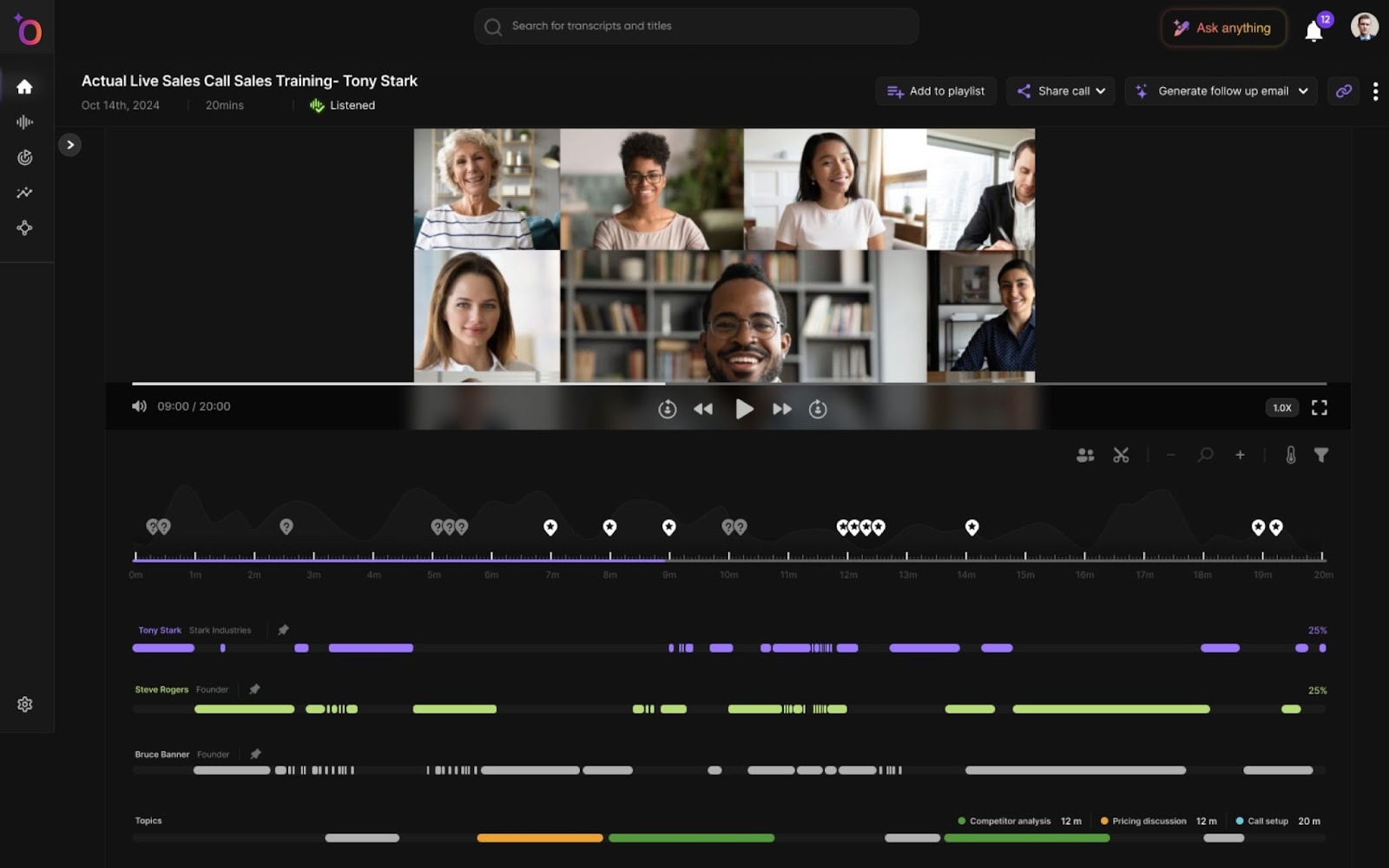
Outdoo is the leading AI Roleplay and Coaching platform for customer-facing teams. Unlike traditional enablement tools that are essentially content repositories, Outdoo focuses on making your reps better sellers through practice and feedback. Reps can jump into realistic sales conversations with AI-driven virtual buyers that mimic real objections and scenarios.
They get instant, objective feedback on how they handled the “call” – and managers get to see who’s truly ready and where each rep needs help. In other words, Outdoo helps your team learn by doing, so that when they’re on actual sales calls, they execute with consistency and confidence.
Pros:
Cons:
Pricing:
Outdoo is offered via custom pricing based on your team’s size, objectives, and specific enablement challenges. The good news is there are no hidden fees or surprise add-ons; pricing scales transparently with usage and any integrations you require.
Testimonial:
2. Highspot
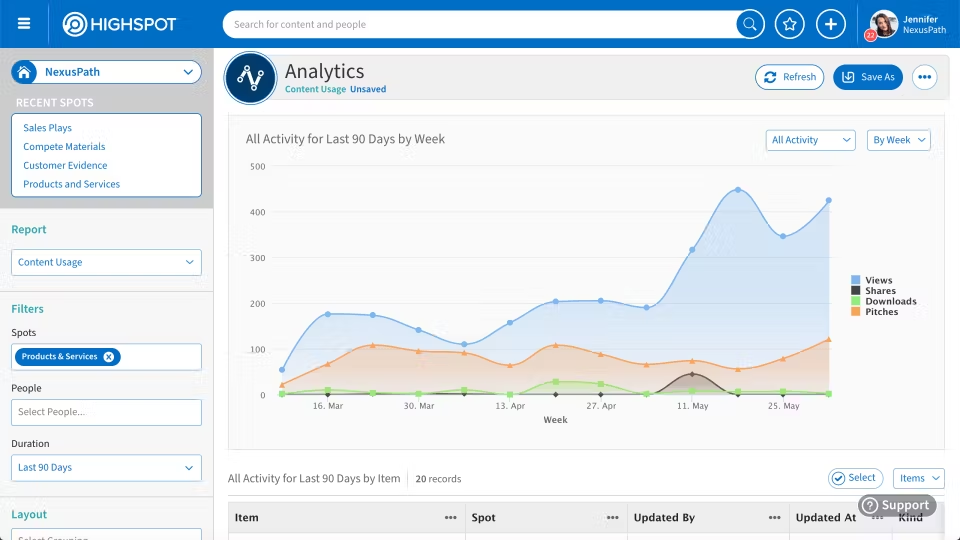
Highspot is one of Seismic’s most direct competitors – a popular sales enablement platform known for making content “customer-ready.” It equips reps with the right sales assets and guidance at exactly the right time. Highspot spans content management, training, and analytics, wrapped in a surprisingly intuitive interface.
Its secret sauce is powerful search and AI-driven content recommendations, so sellers can easily find that perfect case study or pitch deck when engaging a prospect. For teams frustrated with content chaos, Highspot brings a very organized, user-friendly approach.
Pros:
Cons:
Pricing:
Highspot does not list pricing on their site. Generally, they operate on a per-user subscription model with enterprise plans that can be on the higher end (often comparable in cost to Seismic). There’s no free version. Expect to negotiate a custom quote based on your number of users and modules; for reference, many mid-sized companies report paying in the $50–$80 per user/month range for full-featured plans, though deals vary.
Testimonial:
3. Mindtickle
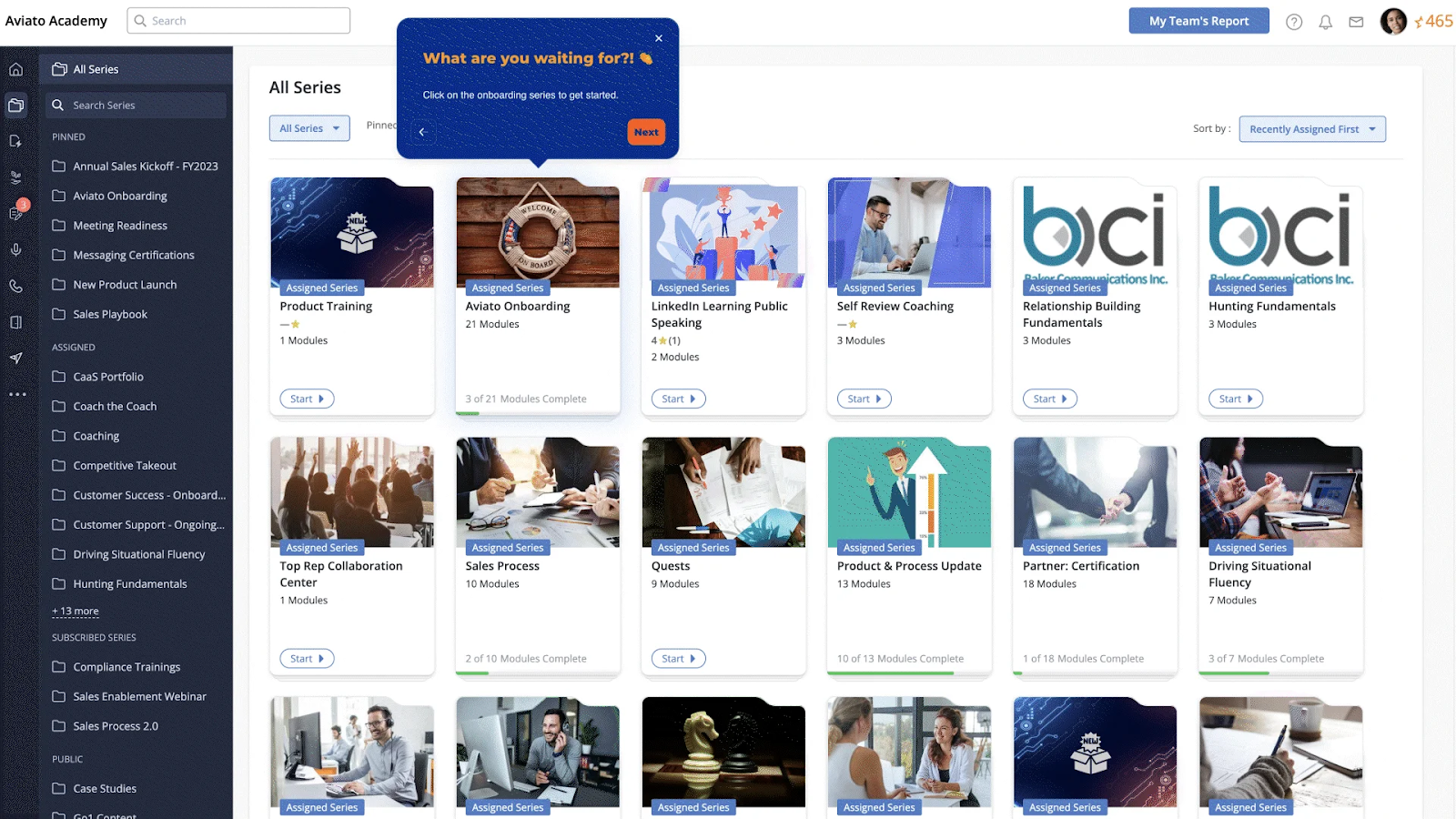
Mindtickle is a revenue enablement platform laser-focused on one question: “Is your team ready to sell?” It’s all about structured onboarding, continuous training, and assessments.
If Seismic is like a content Swiss Army knife, Mindtickle is more like a specialized power tool for training your salesforce. It combines training modules, quizzes, video roleplays, and performance analytics to identify knowledge gaps and certify that reps have the skills and knowledge they need. For large, distributed sales teams, Mindtickle brings process and visibility to learning – transforming enablement from a one-time onboarding event into a continuous improvement cycle.
Pros:
Cons:
Pricing:
Mindtickle’s pricing varies widely. It’s custom-quoted based on factors like number of users, modules needed, and level of support. It isn’t cheap: internal transaction data from Vendr suggests smaller teams might start in the tens of thousands per year, while large enterprise deals can run into six figures annually. One reference point: some large deployments have cost ~$430k per year, whereas an average mid-size deployment might be around $90k/year. In short, budget appropriately – it’s an investment in serious training infrastructure.
Testimonial:
4. Showpad

Showpad is a sales enablement platform that blends a central content hub with interactive sales training tools. It’s designed to help sellers not only find the right materials quickly, but also deliver more engaging buyer experiences. Think of Showpad as part content library, part lightweight LMS, with a dash of buyer engagement features. It’s especially popular among mid-sized and large teams that want a visually polished, easy-to-use solution for managing sales assets and ramping up reps.
Pros:
Cons:
Pricing:
Showpad offers tiered pricing plans. Public info indicates an Essential plan around $32/user/month and a Plus plan around $42/user/month, with enterprise plans above that. These prices can vary based on annual commitments and specific add-ons. There’s typically no free tier, but demos and trials are available. For a full-feature deployment, most mid-size companies will be looking at a solid five-figure annual investment.
Testimonial:
5. Allego
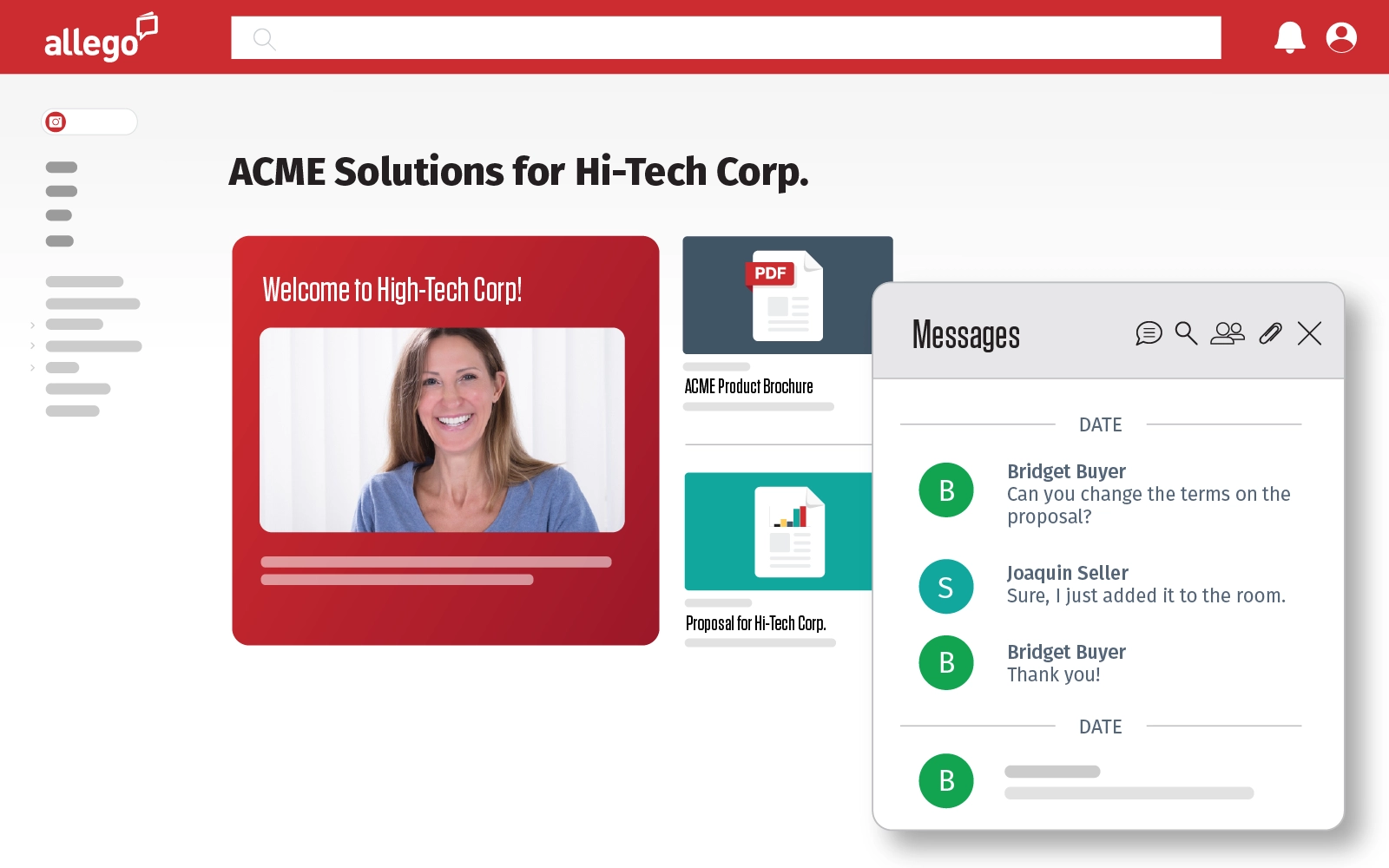
Allego is a comprehensive sales enablement platform built around the idea of continuous learning in the flow of work. It combines a content library, video-based practice/coaching, and collaborative knowledge sharing into one app.
Allego’s philosophy is that sales training shouldn’t be a one-time event or locked in an LMS – it should be happening every day as reps share insights and hone their skills. If you want a tool that enables your team to learn from each other (sharing best practice videos, for example) and from experts, while also managing content, Allego is worth a look.
Pros:
Cons:
Pricing:
Allego’s pricing is customized. They sell product modules (Content Management, Learning, Coaching, etc.) either standalone or bundled. Some sources indicate per-user pricing in the range of $45–$60/user/month for mid-sized deployments, but your mileage will vary. Typically, you’ll get a tailored quote based on how many users and which capabilities you want. There’s no public free tier, though they might offer pilot programs.
Testimonial:
6. Bigtincan
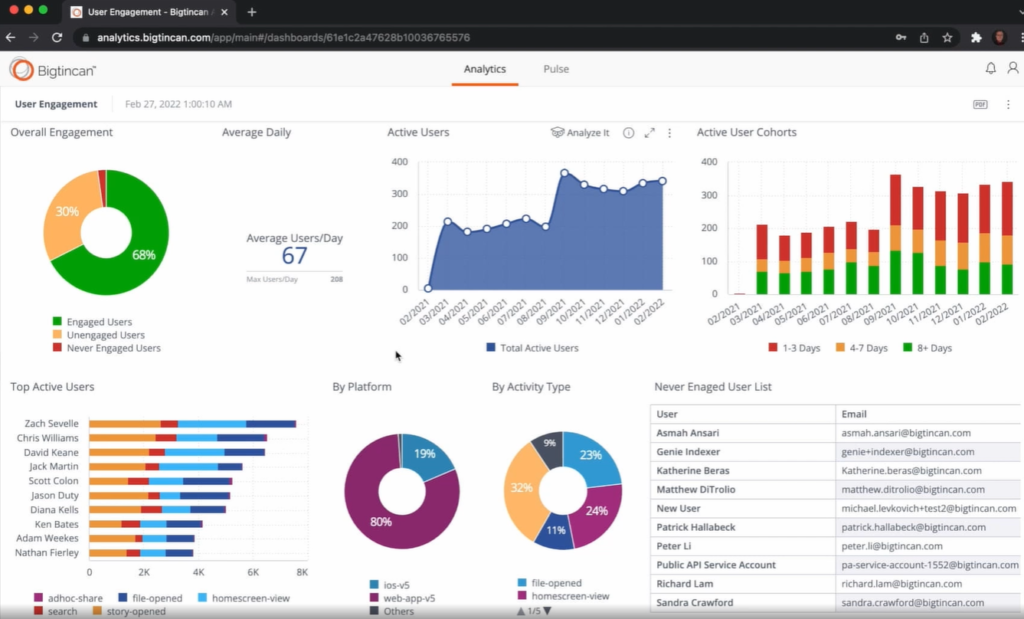
Bigtincan is an AI-powered sales enablement platform that often comes up as an alternative to Seismic for large enterprises. Over the years, Bigtincan acquired various tools (like ClearSlide for content engagement and Brainshark for training), rolling them into a broad enablement automation suite.
The result is a platform that brings everything together: a mobile-friendly content repository, bite-sized training and quizzes, plus interactive coaching and even social selling tools. Bigtincan’s emphasis has always been on making content and training accessible anywhere, especially for field sales teams who need information on the go (even offline). It also layers in AI to recommend content and even simulate buyer interactions (with its GenieAI assistant).
Pros:
Cons:
Pricing:
Bigtincan doesn’t publicly list pricing. They typically do custom quotes depending on which modules you need (Content Hub, Learning Hub, etc.), number of users, and any special integrations. As a frame of reference, it’s an enterprise software – expect pricing similar to other big enablement platforms (i.e. likely in the ballpark of Highspot/Seismic for comparable scopes). Enterprise packages can vary significantly, but don’t expect a low per-user price; it’s more about the value of bundling multiple solutions in one.
Testimonial:
7. Mediafly
Mediafly has evolved from a sales content management tool into a unified “Revenue360” enablement platform that combines traditional enablement with deep analytics and intelligence. Once known mainly for slick sales presentation tools and content hubs, Mediafly made big moves by acquiring InsightSquared (for analytics/forecasting) and ExecVision (for conversation intelligence)\.
The result: a platform where reps not only get the content they need, but also real-time data on which deals to prioritize and how to improve their sales conversations. If you’re looking to connect enablement activities directly to pipeline and revenue insights, Mediafly positions itself as a unique combo of content + coaching + analytics.
Pros:
Cons:
Pricing:
Mediafly doesn’t publicly post pricing. They typically create a custom proposal based on which components you need. It’s safe to assume it’s an enterprise-range investment. One data point from Vendr shows a median customer spending around $38k/year(though likely for a smaller subset of features or users). Larger implementations can easily run into six figures annually if you’re using the full Revenue360 suite. If budget is a primary concern, you’d likely negotiate which modules are must-haves versus nice-to-haves to control costs.
Testimonial:
8. Salesloft

Salesloft is not a traditional enablement platform like Seismic; it’s actually a sales engagement platform. So why is it on this list? Because many sales teams considering enablement tools also weigh solutions like Salesloft (or Outreach, etc.) which focus on the execution side of sales – things like email cadences, call sequences, and task automation.
Salesloft helps reps execute outreach at scale and provides managers with deal pipeline insights and some coaching tools. In recent years, Salesloft has added features that blur into enablement: they have call recording/analytics, “deal risk” alerts, and dashboards that can inform coaching. If your main pain point is that reps aren’t following up or managing pipeline consistently, a sales engagement tool like Salesloft might be an alternative approach to driving revenue outcomes.
Pros:
Cons:
Pricing:
Salesloft’s pricing is custom and comes in different package levels (often Professional, Enterprise, etc., with add-ons for things like Dialer, Conversation Intelligence, etc.). Ballpark figures: ~$75–$125 per user/month for core functionality, and higher for all the bells and whistles. They often require an annual contract. It’s an investment typically justified by increased pipeline generation. Smaller teams might opt for a limited seat deployment (just SDRs, for instance) to control costs.
Testimonial:
9. SalesHood

SalesHood is a sales enablement and readiness platform with an emphasis on team-based learning and coaching. Founded by a former Salesforce enablement leader, SalesHood takes a collaborative approach: reps learn not just from top-down training, but from each other.
The platform includes structured onboarding and training modules, like most enablement tools, but its standout features encourage reps to share pitches, tips, and wins (like a “wisdom of the crowd” approach). It also has tools for managers to coach and for peers to give feedback. SalesHood covers content hosting, training, video coaching, and even digital sales rooms, all in one. It’s a strong pick for mid-market companies that want an all-in-one enablement solution that’s a bit lighter-weight and more social than the heavy enterprise platforms.
Pros:
Cons:
Pricing:
SalesHood typically charges per user, and it’s known to be more affordable than the big guys. Plans reportedly start around $40–$50 per user/month, and can go up depending on add-ons like their Deals module or advanced analytics. They don’t do public pricing, but anecdotal G2 reviews suggest it’s in that mid-range. They do not usually offer a free tier; however, they might have packages for smaller teams with limited features.
Testimonial:
10. Spekit

Spekit approaches enablement from a different angle: rather than a separate platform full of courses and content, Spekit delivers training in the flow of work. It’s essentially a digital adoption and micro-learning tool that plugs into the apps your sales team already uses (like Salesforce, Outreach, Slack, etc.) and provides bite-sized guidance exactly when and where they need it.
Think of Spekit as an in-app help system on steroids – when a rep is in CRM and doesn’t know what to enter in a field or how a process works, Spekit can pop up a tooltip or a how-to card with the answer. It’s great for reinforcing process adherence, tool training, and quick reference info, without pulling reps out of their workflow.
Pros:
Cons:
Pricing:
Spekit uses a SaaS subscription model. It offers a free tier (for a small number of users and basic features). Paid plans for teams start around $15–$25 per user/month depending on volume and features, according to publicly available info. Enterprise pricing is custom but still generally much lower total cost than big enablement platforms. It’s one of the more affordable ways to improve enablement, which is part of its appeal.
Testimonial:
11. Guru
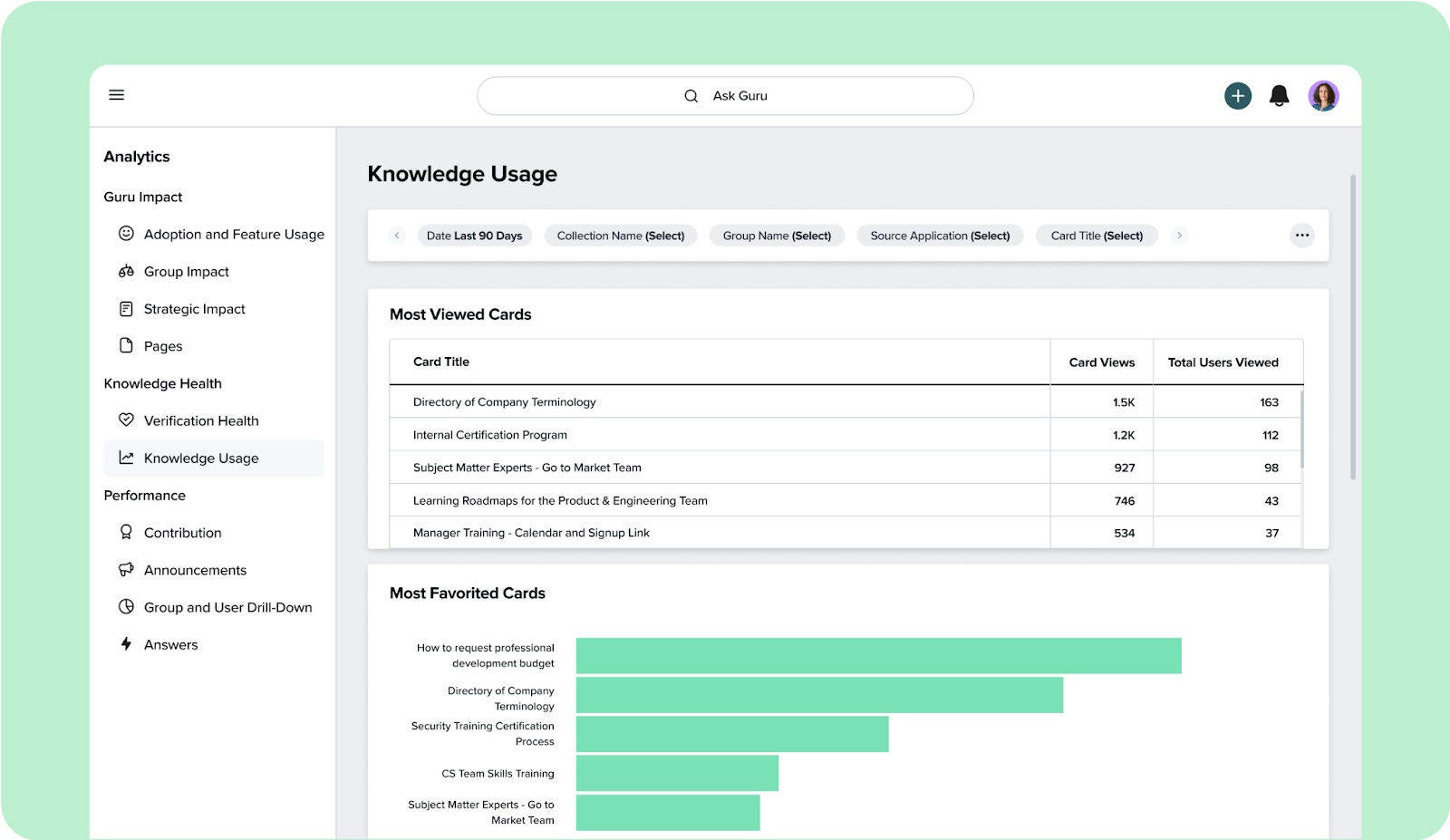
Guru is a knowledge management and internal wiki platform that many sales and support teams use to keep their “source of truth.” If you’ve ever wished your reps could just type a question in Slack or search a browser extension and instantly find the exact answer (whether it’s product info, objection handling, or a pricing policy), that’s what Guru does.
It’s an easily searchable FAQ and documentation repository that lives where your team works – in browsers, Slack, etc. Guru ensures that everyone, from Sales to Success, has accurate, verified answers on demand, instead of relying on tribal knowledge or outdated PDFs. While it’s not a full sales enablement suite (no training modules or content engagement tracking), it’s often used alongside those tools to handle the knowledge sharing piece of enablement.
Pros:
Cons:
Pricing:
Guru offers a free tier for small teams (up to a certain number of users) which is great for trying it out. Paid plans start at around $5–$10 per user/month for basic features, and the Business/Enterprise plans (with verification workflow, analytics, etc.) range roughly $20–$30 per user/month. It’s relatively affordable, and you can scale it as you grow. Most mid-sized companies will be on a Business plan to get the verification and integration features that really make Guru sing.
Testimonial:
Estimate Your ROI with These Alternatives
Every enablement platform promises to boost sales performance – the real question is by how much, and how quickly. You can use the ROI calculator below to get an idea on which alternative would be a best fit for your team.
Which Sales Enablement Tool Should You Choose?
With so many choices, how do you decide which platform (or combination) is right for your needs? Here are a few common scenarios and recommendations to guide you:
- If you’re a growing team on a tight budget, needing the basics (content sharing + light training): Consider a lighter enablement solution. For example, Guru or Spekit can cover knowledge sharing and in-app guidance at a low cost, and a tool like Paperflite (not in our main list, but a lightweight content hub) can manage collateral for a small team. These won’t break the bank and will solve immediate needs for organizing content and answering reps’ questions. Just note: they focus on information access, not deep skill development.
- If your priority is sales training and rep readiness: Outdoo, Mindtickle, and SalesHood all deliver, each with a unique edge. Outdoo is built for AI roleplays and real-time coaching, ideal for teams that want reps to practice, not just learn. Mindtickle is best for analytics-heavy, large-scale programs. SalesHood is simple and peer-driven, great for mid-sized teams. Choose based on whether you value practice, data, or collaboration.
- If you want to embed AI and real-time coaching into daily sales life: Outdoo is a standout here. It’s different from the content libraries, it’s for organizations that realize the missing piece is practice. If you feel your team has the content and knowledge but lacks consistent execution, an AI roleplay and coaching platform like Outdoo can directly address that gap. It can also complement a content hub (for example, you might use Highspot for content and Outdoo for skills coaching – they address different aspects of enablement). Other tools dabble in AI coaching, but Outdoo is purpose-built for it.
- If you need enterprise-grade content management and compliance: Platforms like Highspot or Bigtincan (and of course Seismic itself) are built for this. Highspot is great if you want an intuitive UI with powerful search and Salesforce integration – marketing and sales will both love it for keeping content on-brand. Bigtincan is ideal if you have a lot of field sales reps or need advanced content automation (plus it brings training capabilities as a bonus). These are robust systems for complex needs – just be prepared for the investment in budget and admin effort.
- If what you need is better sales execution & efficiency: A sales engagement platform like Salesloft might actually give you the quickest win. This is especially true if you already have decent content/training in place but struggle with reps not following up enough or lacking a steady sales cadence. By systematizing outreach and providing deal risk alerts, Salesloft can boost activity and consistency. Just remember, it’s solving a different problem – it won’t organize your content or train reps from the ground up.
Most companies will use a combination of tools. For example, you might pick Highspot (for content), plus Outdoo (for coaching), plus Spekit (for in-app guidance). Or you might go with an all-in-one like SalesHood and supplement it with Guru for broader knowledge management. Map out your biggest pain points first, rank them, and then see which tool addresses those best. Also consider your capacity to implement and maintain the solution – a slightly simpler tool that your team actually uses will beat a complex one that never gets fully rolled out.
Finally, involve stakeholders from sales, marketing, and enablement in the decision. A sales manager might gravitate to call coaching, while marketing cares about content usage, and enablement folks look at training analytics. The right choice often satisfies multiple groups or at least doesn’t leave any critical need completely unserved.
Turning Enablement into Impact
The sales enablement software market is booming. Yet as we saw, many teams still struggle to connect all those playbooks and training modules to real-world revenue outcomes. The majority of enablement platforms help you organize content and track training, but far fewer truly change rep behavior on sales calls or show up in the win rates. This leaves sales leaders asking, “We invested in all this content and training, but where’s the payoff?”
The next generation of tools is closing that gap. Whether it’s through AI-driven coaching simulations, just-in-time knowledge delivery, or tying enablement data directly into CRM results, the goal is to make enablement efforts tangible in the metrics that matter – faster ramp, more pipeline, better conversion, predictable revenue.
Platforms like Outdoo are at the forefront of this shift. Outdoo focuses on practice and coaching to ensure knowledge is applied and skills truly improve. It bridges the gap between knowing and doing by using AI roleplays before calls, instant feedback after calls, and continuous reinforcement until every rep performs like a top rep. When combined with a strong content foundation (whether that’s Highspot, Showpad, or even a well-managed Google Drive), this approach turns enablement from a content archive into a performance engine.
At the end of the day, the best tool (or mix of tools) for you is the one that addresses your team’s specific bottlenecks. If you choose wisely, you won’t just deploy another system that “checks the box” for sales enablement – you’ll empower your sellers to have better conversations, you’ll coach them into consistency, and you’ll see that translate into more closed deals. Enablement isn’t about having the most content or the flashiest platform – it’s about making your sales team noticeably more effective.
So, consider where you want to see improvement, and use the comparisons above to find your best-fit solution. With the right alternative to Seismic in place, you can modernize your enablement approach and turn it into true sales impact. Imagine a world where every rep on your team sells as effectively as your very best rep – that’s the vision to keep in mind as you evaluate these options.
Frequently Asked Questions
Outdoo is purpose-built for AI roleplay and real-time coaching, making it ideal for teams focused on execution.
Highspot and Bigtincan are strong contenders, offering robust content organization with better UX and flexibility.
Yes, tools like Guru or Enable.us offer lightweight knowledge sharing and onboarding at a lower cost.
Absolutely, many teams pair Outdoo with tools like Highspot to cover both content and coaching.
Most leave due to high cost, complexity, and limited agility for modern enablement needs.


.svg)

.webp)




